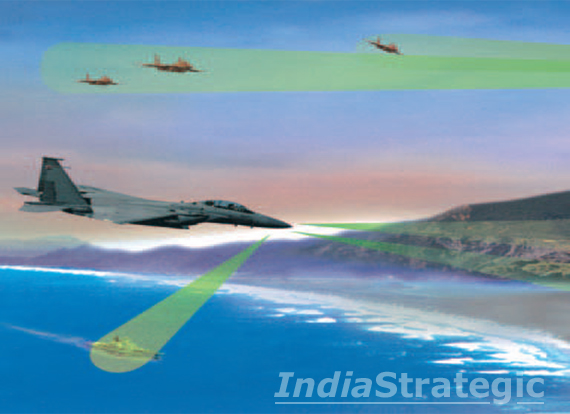Raytheon’s AESA Radar
The Active Electronically Scanned Array (AESA) Radar is regarded a key to modern and future warfare systems.
 Raytheon’s new revolutionary AN/APG-79 AESA radar provides F/A-18 E/F aircrews with powerful new capabilities.
Raytheon’s new revolutionary AN/APG-79 AESA radar provides F/A-18 E/F aircrews with powerful new capabilities.
The AN/APG-79 AESA radar system represents a signifi cant advance in radar technology. Entirely new from front-end array to back-end processor and operational software, the system substantially increases the power of the US Navy’s F/A-18 E/F Super Hornet, making it more lethal and less vulnerable than ever before.
With its active electronic beam scanning — which allows the radar beam to be steered at nearly the speed of light — the APG-79 optimizes situational awareness and provides superior air-to-air and air-to-ground capability. The agile beam enables the radar’s air-to-air and air-to-ground modes to interleave in near-real time, so that pilot and crew can use both modes simultaneously, an unprecedented technological leap.
The APG-79 demonstrates reliability, image resolution, and targeting and tracking range significantly greater than that of the current F/A-18 radar. With its open systems architecture and compact, commercial-off-the shelf (COTS) parts, it delivers dramatically increased capability in a smaller, lighter package. The array is composed of numerous solid-state transmit and receive modules to virtually eliminate mechanical breakdown. Other system components include an advanced receiver/exciter, ruggedized COTS processor, and power supplies.
Since the contract award in 2000, the APG-79 programme has met all its milestones on time and the system has shown exceptional performance in flight tests.
The US Navy plans to buy over 400 APG-79 systems. Around 50 of the newer Super Hornets built by Boeing at its St Louis facility are now fitted with this radar.
Raytheon International President Torkel Patterson says that the radar could be sold to India along with its technology so that it could be integrated on Indian jets like the Tejas Light Combat Aircraft (LCA) but for that there has to be a Transfer of Technology between the Indian and US governments. The radars are adaptable to any platform, he pointed out.
AESA radar systems have the ability to link fighters, bombers and surveillance aircraft, service members in the air and on the ground, integrate data from unmanned aerial vehicles and nontraditional ISR sources to provide the right information at the right time for the right mission.
AESA radars are fielded on a variety of platforms, including the F-15 and F/A-18E/F, the B-2, and the ASTOR surveillance and reconnaissance aircraft.
After designing and building the world’s first operational AESA fighter radar – the APG-63(V)2 for the F-15C, first fielded in 2000 – Raytheon has continuously developed and refined its AESA technology. The culmination of this journey is the POWERFUL ADAPTABLE RELIABLE AIR-TO-AIR AIR-TO-SURFACE new F-15 and F/A-18 radar—the world’s most advanced air-to-air, air-to-surface multimode AESA radars in production, says a Raytheon statement.





